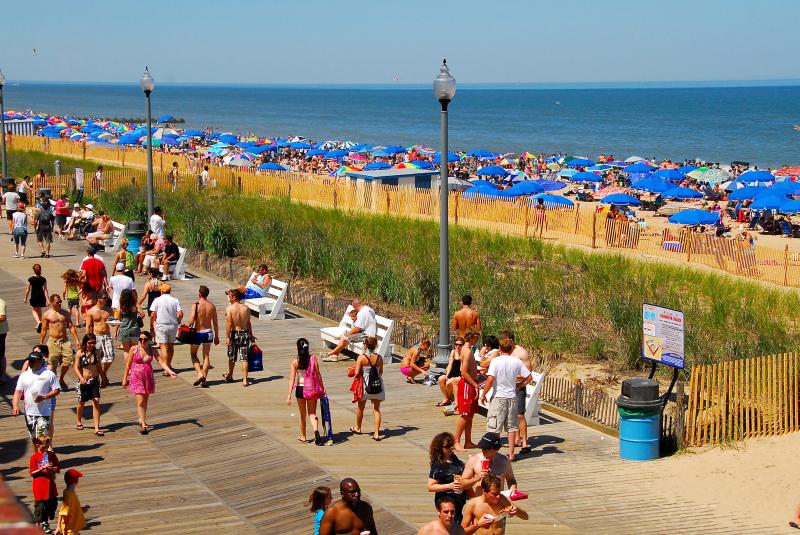The diversity of east vs. west Sussex
Soybean Sussex and Sandy Sussex.
Sussex County really is a tale of two counties, with Georgetown acting as the dividing line, sort of.
Go north, west or south of Georgetown to find a Sussex County far removed from the hustle and bustle of the eastern side.
The eastern part has rapid development, high housing costs, at times gridlock traffic, huge outlets and stores, entertainment, the famous Boardwalk, restaurants and, of course, the beaches. That’s what all the newbies come for.
In the west, you find seemingly endless fields of corn and soybeans, and plenty of small, historic towns. That’s not to say the area is devoid of restaurants, stores and entertainment, but it’s not at the level it is on the eastern side.
West of Seaford, Bridgeville, Laurel and Greenwood to the Maryland state line is the real farm belt of the county. Thousands of acres of corn, wheat and soybeans drive the economy and support hundreds of farm families with deep roots in the Sussex soil.
That’s not to say that farming isn’t a major economic force in the east, where large parcels are still being farmed even as development takes place near them.
The east also has some unique farming, including Bennett Orchards (peaches and blueberries) and Parsons Farms (peaches) near Dagsboro. Also near Dagsboro is the Delaware Botanic Gardens. More than 45% of the land in Sussex is still farmland.
Both sides of the county contribute to the great abundance of fruits and vegetables we all enjoy. Corn and soybeans are the top crops, with broilers the top of the county’s poultry industry. In fact, nearly all grain crops are sold to the poultry plants for feed. Farming and tourism, the county’s top employers, generate nearly $10 billion to the economy.
Great outdoors
One thing both sides have in common is plenty of ways to get outdoors and enjoy the abundance of opportunities like fishing, boating, kayaking and cycling. The system of trails in the Lewes-Rehoboth area attracts cyclists and walkers from all over the county.
Two of the state’s best state parks, Trap Pond near Laurel in the west, and Cape Henlopen near Lewes in the east, call Sussex County home.
Both offer unique adventures, but it’s hard to top a kayak ride through the cypress trees at Trap Pond.
The sad fact is that the vast majority of easterners have never set foot in western Sussex County. They really don’t know what they are missing.
Housing costs an issue
Development is creeping westward from eastern and southeastern Sussex. Millsboro and Georgetown are experiencing growth spurts with major development along Route 113. The two towns, with more affordable home prices, are becoming an alternative to higher-priced homes just a few miles to the east.
The two sides of the county clash when it comes to one of the major issues facing many workers and families who can’t live where they work because of high housing costs. They are forced to seek more affordable housing in the west, and forced to commute every day from west to east.
With houses costing $500,000 to more than $1 million in beach areas of Sussex, working people are forced to go west to find more affordable housing. That housing is hard to come by. Fortunately, large apartment complexes in the Georgetown area and beyond are helping to meet the demand.
If you doubt that workers drive east to work in the resort area, head out onto Route 9 early in the morning and then from 3 to 6 p.m. Even with intersection improvements, traffic frequently backs up into very long lines at traffic signals.
Here come the newbies
There is a different mindset in the east. There are many more retirees who have strong opinions, while in the west, people are more laid-back and take life as it comes.
Eastern Sussex benefits from an influx of residents – including many professional people – who want to be involved in their communities. Most are retired and moved here from Pennsylvania, New Jersey and New York to escape high property taxes and get closer to the water.
This group of newbies supports the communities as active volunteers and provides a major economic shot in the arm to businesses and restaurants.
This group tends to get politically involved, and many have taken on the roles as activists regarding Sussex County government and land use.
Something for everyone
The people who have lived in the beach area for generations are still out there, and they have some great stories to tell about growing up when times were much simpler, before major growth started in the 1990s. But it’s the growing number of newbies whom we can thank for providing buying power to fuel the economy.
Many of the residents in western Sussex belong to families with roots planted firmly in the county.
So what’s the bottom line? The diversity of both sides of the county is a good thing, with unique opportunities for residents to discover the outdoors and the history, and enjoy what the county has to offer.
























































